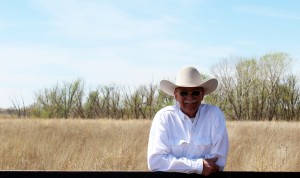
Dan O’Hair, a fifth generation farmer and rancher in Oklahoma followed in his father’s footsteps by preserving the land using conservation programs.
Dan O’Hair is a fifth generation farmer/rancher who lives on a Centennial Farm in the far southeast corner of “No Man’s Land” in Oklahoma. In 1901, his great grandfather and grandfather each staked claim to 160 acres through the Homestead Act. His parents remained on the farm throughout the 1930s depression and Dust Bowl Era. The endurance and persistence of his father led to a significant increase of farm acreage.
“Although the Dust Bowl was tough, there was rainfall and crops were raised on their farm,” said O’Hair.
The announcement of the Soil Bank Act of 1956 allowed O’Hair’s father to enroll cropped land in the program and return it to grass with USDA assistance and a ten-year payment promise. The Act was intended to reduce erosion, curb overproduction and prevent another Dust Bowl from occurring.
In 1986, his father enrolled in the USDA Farm Service Agency (FSA) Conservation Reserve Program (CRP) with the goal of reducing erosion. The O’Hair land was seeded to an improved grass, Old World Bluestem, which promised to establish easily and grow quickly on any soil and with little moisture.
CRP is celebrating its 30th anniversary in 2015 and is among the largest private lands program for conservation used extensively throughout the United States to reduce soil erosion, improve water and air quality and provide wildlife habitat.
The voluntary program allows eligible landowners to receive annual rental payments and cost-share assistance to establish long-term, resource-conserving covers on eligible farmland throughout the duration of their 10-to-15-year contracts.
With the continuation of CRP, O’Hair was able to offer some of his own land into the program and re-enrolled his father’s land. O’Hair was always a part of the family farm. After his career as an electrical engineer ended in 1996, he returned to the family farm full-time, while his father moved to town.
With the farm consisting mostly of grassland and CRP, O’Hair relies on his cow-calf herd for farm income. He developed a grazing system to endure the unpredictable and factually low-rainfall-area of the Oklahoma panhandle. He knows to stockpile forage for the tough times and to allow the grass to recover after utilization.
“For my operation, CRP was a no-brainer based on the program provision that allowed grazing every three years,” said O’Hair. “It fits right into the way I manage my operation. To see new grass sprouting is a testament to good management. I strive to have these pastures look like a carpet of grass with few to no bare spots.”
CRP’s required management provisions go hand-in-hand with O’Hair’s grazing rotation. The rotation allows him to save his non-CRP acres for winter grazing and calving areas.
Last winter, O’Hair only fed 10 bales of hay during a snow, these bales were harvested on his CRP acres to comply with required management provisions. He has also stockpiled plenty of forage since the CRP acreage was used for summer grazing.
O’Hair is proud of the flexibility CRP provides for his ranching operation. CRP contributes to his goals of maintaining healthy grassland.
“I cannot lie,” said O’Hair. “The truth is, I really do not own this land. I am just the steward. When I am gone this land will tell my story. How well did I do?”
Since being established on December 23, 1985, CRP has helped prevent more than 8 billion tons of soil from eroding and protected more than 170,000 stream miles with riparian and grass buffers, more than 100,000 acres of bottomland hardwood trees, nearly 300,000 acres of flood-plain wetlands, and 250,000 acres each for duck nesting habitat and upland bird habitat.
2015 marks the 30th Anniversary of CRP. For an interactive tour of CRP success stories from across the U.S., please visit the FSA CRP 30th Anniversary website at http://www.fsa.usda.gov/CRPis30.






One Response to Conservation Plays Key Role in Preserving Oklahoma Centennial Farm